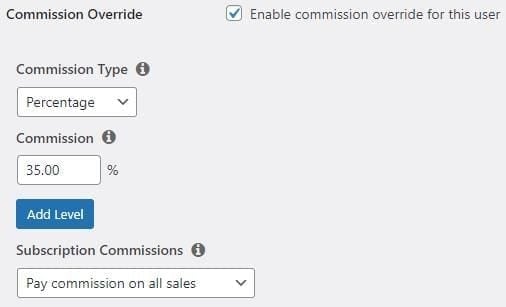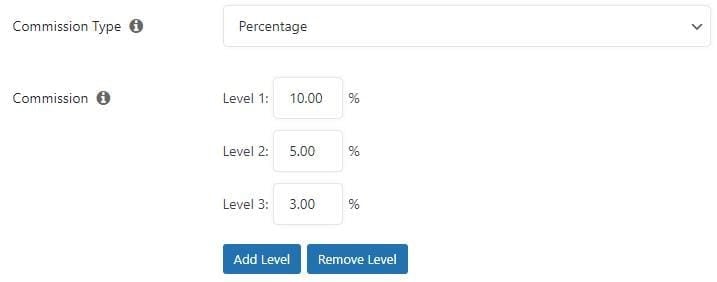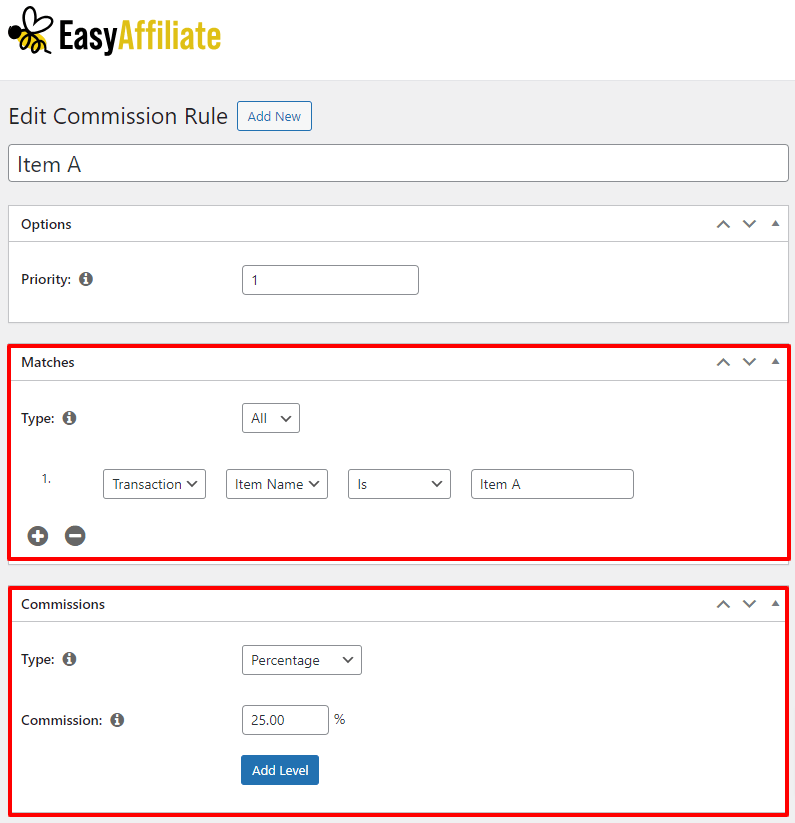Table of Contents
Maintaining a high profit margin is crucial for avoiding revenue loss in your business, whether you’re handling day-to-day operations or rolling out a new affiliate program.
Some businesses struggle to generate a high enough profit to cover their expenses because they don’t calculate their profit margins accurately.
Set your margins too low, and your profits can quickly disappear. Set them too high, and you might scare off buyers, leading to undervalued products.
This challenge becomes even more complex with an affiliate program, where you need to ensure your commissions attract affiliates without compromising your profitability.
In this post, we’ll guide you on how to effectively calculate profit margins for your affiliate program. We’ll also explore how Easy Affiliate’s tools can help you adjust commissions, set up multi-level marketing structures, and customize commission rules based on different products or affiliate performance, ensuring your program is both profitable and competitive.
Why Every Small Business Should Know Their Profit Margin
In simple terms, profit margin is the revenue that remains as profit after all expenses have been deducted. It’s the money you get to keep after covering the costs of producing and selling your products or services.
Understanding the different types of profit margins can help you gain a clearer picture of your business’s financial health:
- Gross Profit Margin focuses on the difference between the revenue generated from selling your products (cost of goods sold) and the amount you spent on acquiring or producing those products.
- Operating Profit Margin takes it a step further by including operating expenses – like labor costs, transportation, and other day-to-day business expenses – on top of the cost of goods sold.
- Net Profit Margin provides the most comprehensive view by accounting for all expenses, including taxes, interest, and operating costs, along with the cost of goods sold. It’s essentially the amount left over after deducting every cost associated with running your business.
Knowing your profit margins also provides additional insights into key aspects of your business, such as:
- Pricing Strategy. Strong margins suggest that you’ve found the right balance – pricing your products or services high enough to cover costs and generate profit, while still being attractive to customers.
- Financial Health. A healthy profit margin is a clear indicator that your business is financially stable. It shows that you’re not just covering your expenses but also generating surplus funds that can be reinvested into the business for growth. This financial strength is essential for long-term success and provides reassurance to investors, banks, and partners that your business is well-managed and sustainable.
- Cost Management: Monitoring your profit margins helps you pinpoint areas where you might be overspending. Whether it’s on supplies, marketing, or other operational expenses, understanding your margins allows you to identify inefficiencies and make adjustments.
Ultimately, calculating your profit margin empowers you to make smarter choices, fostering sustainable growth and positioning your business for long-term success.
What is a Reasonable Profit Margin for a Small Business?
For most small businesses, aiming for a profit margin between 7% and 10% is a good goal. This range gives you a buffer to handle unexpected costs while still making a healthy profit.
Optimizing Your Affiliate Program for High Profit Margins
When you bring an affiliate program into the mix, you need to think of it as an extension of your business with its own set of rules.
And like your overall profit margin, your affiliate program’s margin needs to be managed carefully to stay healthy and profitable.
To ensure your affiliate program is profitable, it’s essential to revisit the 3 profit margin types, but this time, consider how they apply uniquely to an affiliate program:
- Gross Profit Margin: This margin focuses on the revenue generated from affiliate sales minus the direct costs of the products sold. It provides a basic overview of how much you’re making from sales before factoring in the costs of managing the affiliate program itself.
- Operating Profit Margin: This margin goes a step further by including both the cost of goods sold and your operating expenses, such as software costs, affiliate commissions, and additional marketing efforts.
- Net Profit Margin: The most comprehensive metric, net profit margin, includes all expenses – product costs, operating costs, commissions, ect.– subtracted from your total revenue. This gives you a true sense of your program’s profitability after all costs are considered.
To maintain a high profit margin affiliate program, you need to (1) carefully calculate the gross profit margin for a product, (2) account for all other affiliate program expenses, and (3) set your affiliate commissions at a level that motivates affiliates while keeping your business profitable.
All that’s up next!
What is a Good Profit Margin for a Product?
The ideal profit margin for a product can vary depending on your industry, production costs, and pricing strategy.
Generally, a healthy margin falls between 20% and 50%, giving you room to cover expenses and drive growth.
For luxury or high-end products, margins might soar past 50%, thanks to premium pricing and strong brand value. On the flip side, in industries with fierce competition or lower-priced goods, margins might hover closer to 20%.
Additionally, if you’re thinking about introducing an affiliate program, you’ll need to account for the commissions paid out to affiliates.
This may require a slight adjustment in your product profit margin to ensure your business remains profitable while still offering attractive incentives for affiliates.
Aligning Affiliate Commissions with Your Profit Margin
When working with successful affiliate partners, the commissions you pay will significantly impact your profit margin.
You want your commissions to be enticing enough to keep affiliates motivated and eager to promote your products. But it’s equally important to ensure these commissions don’t cut too deeply into your profits.
Understanding your profit margins allows you to make smart decisions about how much commission you can afford to pay. The right commission rate can drive more affiliate activity, boost sales, and ultimately enhance your overall profitability.
However, if commissions are set too high, they can start to erode your profits, making the program less sustainable.
To keep things in balance, it’s essential to regularly monitor your profit margins and adjust commission rates as needed. This approach ensures that your affiliate program remains competitive for affiliates while keeping your business profitable and growing.
How to Use Easy Affiliate to Customize Affiliate Commissions
Setting up or managing an affiliate program is all about balance – especially when it comes to maintaining a healthy profit margin.
The right tools can make this process much easier, and that’s where Easy Affiliate comes in.
This powerful affiliate management platform makes it simple to customize commissions, helping you align them with your business goals without compromising your bottom line.
Here’s how you can use Easy Affiliate to tailor your commission structures, both individually and across multiple levels, all while keeping your profit margins in check:
Individual Commissions
With Easy Affiliate, you can easily adjust commission rates for specific affiliates directly through their profiles.
This feature allows you to reward your top performers with higher commissions or strategically set rates based on the unique strengths of each affiliate.


By customizing commissions individually, you can better motivate your affiliates without letting higher payouts erode your profits.
>> Learn how to pay affiliates different commission rates.
Multi-Level Commissions
Easy Affiliate also supports multi-level commission structures, which allow affiliates to earn not just on their own sales but also on the sales made by those they recruit.
While this tiered system can significantly expand your sales network and increase revenue, it’s crucial to manage these commissions carefully.
Multi-level commissions can quickly add up, so it’s essential to monitor how they impact your overall profit margin to avoid diminishing returns.

The Easy Affiliate Commissions Levels add-on gives you the flexibility to configure either percentage-based or fixed-amount commissions per sale. Choosing the right structure is key to maintaining profitability.
A percentage-based commission can scale with higher-priced products, ensuring your margins remain intact, while fixed commissions offer predictability in cost management.
Both options allow you to create a commission structure that aligns with your financial objectives, helping you strike the perfect balance between incentivizing affiliates and protecting your profit margins.
>> Learn how to set up a multi-level affiliate commission structure.
Product Based Commissions
To further enhance the effectiveness of your affiliate program and protect your profit margin, consider utilizing Easy Affiliate’s Commission Rules add-on.
This powerful feature allows you to tailor commissions based on product types or affiliate performance, ensuring that your program remains dynamic and responsive to business needs without compromising profitability.
By setting different commission rates for various products, depending on their profit margins or strategic importance, you can guide affiliate efforts toward promoting the items that matter most to your bottom line.

For example, offering higher commissions on products with larger profit margins can incentivize affiliates to focus on these key items, maximizing profitability.
On the other hand, you might lower commissions on products with tighter margins to ensure your overall profits remain healthy.
By using these strategies and tools, you can dynamically adjust your affiliate program to optimize growth, maintain a motivated affiliate network, and ensure that your commission structure supports both your business objectives and a healthy profit margin.
Additional Tips on How to Set Affiliate Commissions to Maintain a High Profit Margin
Successfully integrating an affiliate program into your business requires more than just offering competitive commissions – it calls for a strategic approach that aligns with your profit goals.
Here are some additional tips to help you fine-tune your commission structure:
Analyze Your Competitors
Before setting your commission rates, it’s essential to understand what your competitors are offering.
By analyzing industry standards, you can ensure your program remains competitive. If your rates are too low, attracting affiliates might be a challenge.
However, offering significantly higher commissions than your competitors could unnecessarily cut into your profit margin.
Create Tiered Commissions
Tiered commissions are a great way to motivate your affiliates to reach higher sales targets while safeguarding your profit margins.
For example, you could offer a base commission of 10%, with an increase to 15% for affiliates who surpass a certain sales threshold.
This structure rewards top performers and encourages increased effort, all while keeping your overall commission expenses under control.
Monitor and Adjust Your Commissions From Time-to-time
An affiliate program isn’t something you can set up and forget about. The marketplace is constantly evolving, and what works today might not be as effective tomorrow.
It’s important to regularly monitor your commission rates and their impact on your profit margins. If you notice your commissions are too high or too low, don’t hesitate to make adjustments.
Read >> 3 Important Maintenance Tasks for Your Affiliate Program
Staying flexible and responsive ensures that your affiliate program continues to drive growth while remaining financially sustainable.
Be Transparent about Your Commission
Finally, be open with your affiliates about how commission structures are set up and how they can maximize their earnings.
Transparency fosters trust and encourages a more committed relationship with your affiliates.
It also helps manage expectations and minimizes misunderstandings, ensuring everyone is aligned and working toward the same goals.
Conclusion
Mastering profit margins is key to running a successful affiliate program. By understanding profit margins can smartly decide how much to pay your affiliates. This balance is essential because it ensures your program is both appealing to affiliates and profitable for you.
Using a tool like Easy Affiliate, you can tailor commission rates to fit different products or based on how well an affiliate is doing. This flexibility helps motivate your affiliates to perform better and aligns their goals with yours, all while keeping your bottom line healthy.
Don’t forget to adjust your strategies as needed and keep the lines of communication open with your affiliates. This approach keeps everyone on the same page and your program competitive.
Are you ready to turn your affiliate program into a valuable money-making business? Start using Easy Affiliate to fine-tune your commission structures today.
If you liked this article, be sure to follow us on Twitter, Facebook, Pinterest, and LinkedIn! And don't forget to subscribe in the box below





Leave a Reply